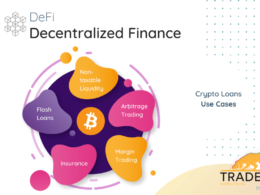Quick Links
In today’s rapidly evolving financial landscape, the age-old debate of traditional fiat currency versus the burgeoning world of digital assets has taken a new twist with the rise of stablecoins. While fiat currencies, backed by governments and central banks, have been the cornerstone of our global economy for centuries, stablecoins—digital currencies pegged to the value of traditional assets—have emerged as a novel bridge between the analogue and digital realms. According to CoinMarketCap, the market cap of stablecoins currently stands around $125 billion, highlighting their burgeoning role in global financial systems. This astronomical rise begs the question: Are stablecoins poised to redefine the very concept of money in the digital age, and if so, at what cost to the established order of fiat currencies?
A Bit of Background on Fiat Currencies and Stablecoins
In the world of money, we have something called fiat currencies. These are types of money that come from governments, like the US Dollar or Euro. They don’t have any physical things like gold to back them up, but people trust them because the government says they’re okay to use. The folks in charge of these kinds of money, called central banks, make sure there’s a manageable amount of it going around and control how much it costs to borrow. These monies are used by lots of people and are steady for buying stuff and saving for later. But sometimes, they can change in value because of things like how the economy is doing or what the government decides to do with them. These fiat currencies are super important for the whole world’s money system, making it possible for us to buy things every day, and they rely on the government being in charge and doing a good job.
If you’re wondering how much money is in circulation around the world, the Bank for International Settlements estimated it to be about $8.28 trillion US dollars in 2021. This includes the money from 20 major countries and the euro area. But remember, there are almost 200 countries in the world, so this is just a rough guess for a specific group of countries and their money.
How did Stablecoins come into existence?
Stablecoins came about as a way to deal with the ups and downs of cryptocurrencies like Bitcoin. The very first stablecoin, called “Tether” (USDT), was introduced in 2014. Tether’s main goal was to keep its value steady by tying it to a regular currency, the US Dollar, with a 1:1 ratio. This big innovation set the stage for lots of other stablecoins, each with its own special methods and ways of being backed by assets. Stablecoins have become popular because they can bring together the good parts of cryptocurrencies and the stability of regular money, opening up new possibilities in digital finance.
Fiat Currencies: The Pros and Cons
Advantage No. 1: Stability and Widespread Acceptance
Fiat currencies hold their ground as a cornerstone of global finance due to their stability and widespread acceptance. These government-issued currencies, like the US Dollar and the Euro, enjoy unparalleled trust and circulation. As of Q1 2023, the US Dollar accounted for approximately 54% of the world’s known central bank foreign exchange reserves, underlining its global significance. Similarly, the Euro, utilized by 19 European Union countries, plays a substantial role in international trade, accounting for about 18.30% of global currency reserves. This widespread adoption of fiat currencies is a testament to the enduring faith in their stability and utility, anchoring them firmly in the heart of the global financial system.
Advantage No.2: Centralized Control and Government Backing
Centralized control and government backing are key advantages of fiat currencies. With a central authority overseeing their issuance and regulation, fiat currencies can be carefully managed to maintain stability and prevent excessive inflation. Government backing instills trust in the currency, as it is backed by the full faith and credit of a nation. This support ensures that fiat currencies are widely accepted for transactions and serve as a reliable store of value. These attributes make fiat currencies an essential tool for governments in managing their economies and providing financial stability to their citizens.
Disadvantage No.1: Inflation and Devaluation
Inflation and devaluation of fiat currencies pose significant disadvantages to economies worldwide. Inflation erodes the purchasing power of money, making it more expensive for individuals to buy goods and services. For instance, in 2021, the United States experienced an annual inflation rate of approximately 5.4%, significantly impacting consumers’ ability to stretch their dollars.
Devaluation, on the other hand, decreases the exchange rate of a currency against other global currencies, making imports more expensive. In 2020, the Venezuelan bolívar suffered a staggering devaluation of over 98%, resulting in hyperinflation and severe economic turmoil. These adverse effects underscore the importance of prudent monetary policies to maintain currency stability and safeguard the financial well-being of citizens.
Disadvantage No.2: Dependence of Collateral Assets
The dependency of fiat currencies on collateral assets can be a significant disadvantage, as it can introduce instability and vulnerability into the financial system. This reliance on collateral is evident in the global practice of fractional reserve banking, where banks lend out a portion of their deposits based on the collateral they hold.
For instance, in 2008, during the global financial crisis, the over-reliance on mortgage-backed securities as collateral led to a severe banking crisis, contributing to the economic downturn. This interconnection highlights the fragility of fiat currencies, as their value can be influenced by the performance of collateral assets, making the system susceptible to sudden shocks and market fluctuations.
Stablecoins: The Pros and Cons
Advantage no.1: Stability and Widespread Acceptance
Stablecoins offer a significant advantage in terms of stability and widespread acceptance in the world of digital currencies. Unlike many cryptocurrencies known for their price volatility, stablecoins are designed to maintain a stable value, often pegged to a fiat currency like the US dollar. This stability makes them attractive for everyday transactions and a reliable store of value. Their widespread use in sectors such as DeFi (Decentralized Finance) and cross-border payments underscores their role in providing a dependable and efficient alternative to traditional currencies.
Advantage no.2: Accessibility and Global Reach
One of the key advantages of stablecoins is their accessibility and global reach. These digital assets can be transferred and accessed by anyone with an internet connection, eliminating the barriers associated with traditional banking systems. They provide financial services to the unbanked and underbanked populations worldwide, promoting financial inclusion. This accessibility makes stablecoins a powerful tool for cross-border payments, remittances, and financial services, fostering financial empowerment and economic growth for individuals and businesses around the world.
Disadvantage no.1: Regulatory Concern
Regulatory concerns loom large as a significant disadvantage for stablecoins. Governments and financial institutions are increasingly scrutinizing these digital assets due to fears related to money laundering, consumer protection, and financial stability. The evolving regulatory landscape could impact the growth and adoption of stablecoins, introducing uncertainties that may hinder their development and utility in the financial ecosystem. Striking a balance between innovation and regulatory compliance remains a critical challenge for stablecoin projects.
Disadvantage no.2: Centralization Vs Decentralization Debate
The centralization vs. decentralization debate poses a significant disadvantage for stablecoins. While some stablecoin projects aim for decentralization to ensure transparency and security, others lean towards centralization to maintain stability. The majority of widely used stablecoins were centralized, raising concerns about control and manipulation by a select few entities. This centralization can undermine the principles of blockchain technology, leading to trust issues and potential vulnerabilities. Striking the right balance between stability and decentralization remains a critical challenge for the stablecoin ecosystem, as it navigates the complex terrain of regulatory compliance and user trust in the years ahead.
Disadvantage no.3: Dependence on Collateral Assets
The dependence of stablecoins on collateral assets can be a disadvantage, as it introduces risks related to asset management and market fluctuations. Many stablecoins are backed by assets like cryptocurrencies or fiat currency held in reserve.For instance, if a stablecoin is primarily backed by cryptocurrencies, a sudden drop in the crypto market could lead to insolvency or under-collateralization, risking the stability of the stablecoin. This reliance on collateral assets makes stablecoins susceptible to market volatility and raises questions about their ability to maintain their pegged value during periods of extreme market stress.
Comparing The Two: Fiat Currencies & Stablecoins
Fiat currencies and stablecoins each offer distinct advantages and disadvantages. Fiat currencies, issued and regulated by governments, benefit from widespread acceptance and stability but can suffer from inflation and lack of accessibility. In contrast, stablecoins, typically digital assets pegged to a stable asset like a fiat currency, provide stability and accessibility for global transactions, yet face regulatory uncertainties and dependence on collateral assets. The choice between them depends on individual preferences, with fiat currencies offering familiarity and government backing, while stablecoins offer innovation and efficiency in the evolving digital financial landscape.
Here are examples of how fiat currencies and stablecoins are used in the real world:
Fiat Currencies
- Everyday Transactions: People use fiat currencies, like the US dollar or the Euro, for daily purchases, such as buying groceries, paying rent, or dining at restaurants.
- International Trade: Businesses engaged in global trade rely on fiat currencies for buying and selling goods and services across borders, facilitating international commerce.
- Government Expenses: Governments use their national fiat currencies to fund public services, infrastructure projects, and pay government employees.
Stablecoins:
- Cryptocurrency Trading: Stablecoins like Tether (USDT) are used by cryptocurrency traders as a stable store of value during market volatility, allowing them to quickly exit the cryptocurrency market when needed.
- Cross-Border Remittances: Migrant workers and individuals use stablecoins to send remittances across borders due to their low transaction fees and faster processing times compared to traditional remittance services.
- Decentralized Finance (DeFi): Stablecoins like DAI are used as collateral in DeFi protocols, enabling users to borrow and lend cryptocurrencies, earn interest, and participate in various financial activities without relying on traditional banks.
These examples highlight how both fiat currencies and stablecoins serve various purposes in the real world, catering to different needs and use cases.
The Future of Money
In my opinion, stablecoins have the potential to play a substantial role in the future of money. Their digital nature, global accessibility, and stability make them an attractive alternative to traditional fiat currencies. With the increasing digitization of financial services and the growth of blockchain technology, stablecoins offer the advantages of efficiency, transparency, and accessibility that fiat currencies can’t match. However, it’s crucial to address regulatory concerns and ensure proper oversight to harness the full potential of stablecoins while maintaining financial stability and security. While fiat currencies will likely remain a fundamental component of our financial system, stablecoins have the potential to complement and enhance it in many ways.
Conclusion
In conclusion, the financial landscape is undergoing a profound transformation, with fiat currencies and stablecoins at the forefront of this evolution. While fiat currencies have long been the bedrock of the global economy, offering stability and widespread acceptance, they are not without their flaws, including vulnerability to inflation and dependence on collateral assets.
On the other hand, stablecoins bring innovation, accessibility, and stability to the table, making them well-suited for the digital age. The rise of stablecoins is a testament to their potential to redefine the concept of money, offering a bridge between the traditional financial system and the digital realm.
However, regulatory challenges and the centralization vs. decentralization debate underscore the need for careful navigation as we shape the future of money. The choice between fiat currencies and stablecoins ultimately depends on individual preferences and the evolving dynamics of the financial world, where both have important roles to play.













